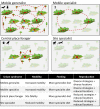Urbanisation generates multiple trait syndromes for terrestrial animal taxa worldwide
- PMID: 37550318
- PMCID: PMC10406945
- DOI: 10.1038/s41467-023-39746-1
Urbanisation generates multiple trait syndromes for terrestrial animal taxa worldwide
Abstract
Cities can host significant biological diversity. Yet, urbanisation leads to the loss of habitats, species, and functional groups. Understanding how multiple taxa respond to urbanisation globally is essential to promote and conserve biodiversity in cities. Using a dataset encompassing six terrestrial faunal taxa (amphibians, bats, bees, birds, carabid beetles and reptiles) across 379 cities on 6 continents, we show that urbanisation produces taxon-specific changes in trait composition, with traits related to reproductive strategy showing the strongest response. Our findings suggest that urbanisation results in four trait syndromes (mobile generalists, site specialists, central place foragers, and mobile specialists), with resources associated with reproduction and diet likely driving patterns in traits associated with mobility and body size. Functional diversity measures showed varied responses, leading to shifts in trait space likely driven by critical resource distribution and abundance, and taxon-specific trait syndromes. Maximising opportunities to support taxa with different urban trait syndromes should be pivotal in conservation and management programmes within and among cities. This will reduce the likelihood of biotic homogenisation and helps ensure that urban environments have the capacity to respond to future challenges. These actions are critical to reframe the role of cities in global biodiversity loss.
© 2023. Springer Nature Limited.
Conflict of interest statement
The authors declare no competing interests.
Figures





References
-
- Soanes K, Lentini PE. When cities are the last chance for saving species. Front. Ecol. Environ. 2019;17:225–231.
-
- United Nations. World Urbanization Prospects: The 2018 Revision. United Nations Department of Economic and Social Affairs. Population Division, New York (2019).
-
- McDonald RI, et al. Research gaps in knowledge of the impact of urban growth on biodiversity. Nat. Sustain. 2020;3:16–24.

